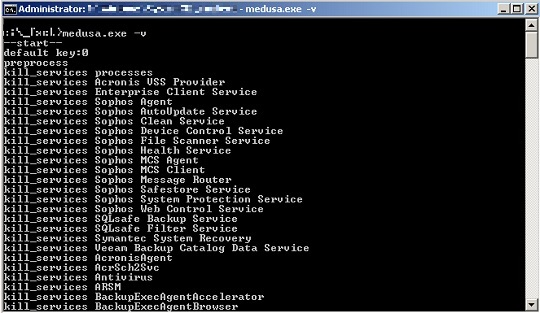Ransom.Win32.MEDUSA.SM
Win32:RansomX-gen [Ransom] (AVAST)
Windows

Tipo de malware
Ransomware
Destructivo?
No
Cifrado

In the Wild:
Sí
Resumen y descripción
It arrives on a system as a file dropped by other malware or as a file downloaded unknowingly by users when visiting malicious sites.
Detalles técnicos
Detalles de entrada
It arrives on a system as a file dropped by other malware or as a file downloaded unknowingly by users when visiting malicious sites.
Instalación
Agrega los procesos siguientes:
- net stop "{Service name}" /y
- taskkill /F /im {Process name} /T
- vssadmin Delete Shadows /all /quiet
- vssadmin resize shadowstorage /for={Drive letter} /on={Drive letter} /maxsize={Size in MB}
- vssadmin resize shadowstorage /for={Drive letter} /on={Drive letter} /maxsize=unbounded
- cmd /c ping localhost -n 3 > nul; & del {Malware Name}
- powershell -executionpolicy bypass -File {Powershell script path}
- powershell -Command "& {{Powershell script path}}"
Finalización del proceso
Finaliza los servicios siguientes si los detecta en el sistema afectado:
- via net stop:
- Acronis VSS Provider
- Enterprise Client Service
- Sophos Agent
- Sophos AutoUpdate Service
- Sophos Clean Service
- Sophos Device Control Service
- Sophos File Scanner Service
- Sophos Health Service
- Sophos MCS Agent
- Sophos MCS Client
- Sophos Message Router
- Sophos Safestore Service
- Sophos System Protection Service
- Sophos Web Control Service
- SQLsafe Backup Service
- SQLsafe Filter Service
- Symantec System Recovery
- Veeam Backup Catalog Data Service
- AcronisAgent
- AcrSch2Svc
- Antivirus
- ARSM
- BackupExecAgentAccelerator
- BackupExecAgentBrowser
- BackupExecDeviceMediaService
- BackupExecJobEngine
- BackupExecManagementService
- BackupExecRPCService
- BackupExecVSSProvider
- bedbg
- fDCAgent
- EPSecurityService
- EPUpdateService
- EraserSvc11710
- EsgShKernel
- FA_Scheduler
- IISAdmin
- IMAP4Svc
- macmnsvc
- masvc
- MBAMService
- MBEndpointAgent
- McAfeeEngineService
- McAfeeFramework
- McAfeeFrameworkMcAfeeFramework
- McShield
- McTaskManager
- mfemms
- mfevtp
- MMS
- mozyprobackup
- MsDtsServer
- MsDtsServer100
- MsDtsServer110
- MSExchangeES
- MSExchangeIS
- MSExchangeMGMT
- MSExchangeMTA
- MSExchangeSA
- MSExchangeSRS
- MSOLAP$SQL_2008
- MSOLAP$SYSTEM_BGC
- MSOLAP$TPS
- MSOLAP$TPSAMA
- MSSQL$BKUPEXEC
- MSSQL$ECWDB2
- MSSQL$PRACTICEMGT
- MSSQL$PRACTTICEBGC
- MSSQL$PROFXENGAGEMENT
- MSSQL$SBSMONITORING
- MSSQL$SHAREPOINT
- MSSQL$SQL_2008
- MSSQL$SYSTEM_BGC
- MSSQL$TPS
- MSSQL$TPSAMA
- MSSQL$VEEAMSQL2008R2
- MSSQL$VEEAMSQL2012
- MSSQLFDLauncher
- MSSQLFDLauncher$PROFXENGAGEMENT
- MSSQLFDLauncher$SBSMONITORING
- MSSQLFDLauncher$SHAREPOINT
- MSSQLFDLauncher$SQL_2008
- MSSQLFDLauncher$SYSTEM_BGC
- MSSQLFDLauncher$TPS
- MSSQLFDLauncher$TPSAMA
- MSSQLSERVER
- MSSQLServerADHelper100
- MSSQLServerOLAPService
- MySQL80
- MySQL57
- ntrtscan
- OracleClientCache80
- PDVFSService
- POP3Svc
- ReportServer
- ReportServer$SQL_2008
- ReportServer$SYSTEM_BGC
- ReportServer$TPS
- ReportServer$TPSAMA
- RESvc
- sacsvr
- SamSs
- SAVAdminService
- SAVService
- SDRSVC
- SepMasterService
- ShMonitor
- Smcinst
- SmcService
- SMTPSvc
- SNAC
- SntpService
- sophossps
- SQLAgent$BKUPEXEC
- SQLAgent$ECWDB2
- SQLAgent$PRACTTICEBGC
- SQLAgent$PRACTTICEMGT
- SQLAgent$PROFXENGAGEMENT
- SQLAgent$SBSMONITORING
- SQLAgent$SHAREPOINT
- SQLAgent$SQL_2008
- SQLAgent$SYSTEM_BGC
- SQLAgent$TPS
- SQLAgent$TPSAMA
- SQLAgent$VEEAMSQL2008R2
- SQLAgent$VEEAMSQL2012
- SQLBrowser
- SQLSafeOLRService
- SQLSERVERAGENT
- SQLTELEMETRY
- SQLTELEMETRY$ECWDB2
- SQLWriter
- SstpSvc
- svcGenericHost
- swi_filter
- swi_service
- swi_update_64
- TmCCSF
- tmlisten
- TrueKey
- TrueKeyScheduler
- TrueKeyServiceHelper
- UI0Detect
- VeeamBackupSvc
- VeeamBrokerSvc
- VeeamCatalogSvc
- VeeamCloudSvc
- VeeamDeploymentService
- VeeamDeploySvc
- VeeamEnterpriseManagerSvc
- VeeamMountSvc
- VeeamNFSSvc
- VeeamRESTSvc
- VeeamTransportSvc
- W3Svc
- wbengine
- WRSVC
- MSSQL$VEEAMSQL2008R2
- SQLAgent$VEEAMSQL2008R2
- VeeamHvIntegrationSvc
- swi_update
- SQLAgent$CXDB
- SQLAgent$CITRIX_METAFRAME
- SQL Backups
- MSSQL$PROD
- Zoolz 2 Service
- MSSQLServerADHelper
- SQLAgent$PROD
- msftesql$PROD
- NetMsmqActivator
- EhttpSrv
- ekrn
- ESHASRV
- MSSQL$SOPHOS
- SQLAgent$SOPHOS
- AVP
- klnagent
- MSSQL$SQLEXPRESS
- SQLAgent$SQLEXPRESS
- wbengine
- kavfsslp
- KAVFSGT
- KAVFS
- mfefire
Finaliza los procesos siguientes si detecta que se ejecutan en la memoria del sistema afectado:
- via taskkill /F /im:
- zoolz.exe
- agntsvc.exe
- dbeng50.exe
- dbsnmp.exe
- encsvc.exe
- excel.exe
- firefoxconfig.exe
- infopath.exe
- isqlplussvc.exe
- msaccess.exe
- msftesql.exe
- mspub.exe
- mydesktopqos.exe
- mydesktopservice.exe
- mysqld.exe
- mysqld-nt.exe
- mysqld-opt.exe
- ocautoupds.exe
- ocomm.exe
- ocssd.exe
- onenote.exe
- oracle.exe
- outlook.exe
- powerpnt.exe
- sqbcoreservice.exe
- sqlagent.exe
- sqlbrowser.exe
- sqlservr.exe
- sqlwriter.exe
- steam.exe
- synctime.exe
- tbirdconfig.exe
- thebat.exe
- thebat64.exe
- thunderbird.exe
- visio.exe
- winword.exe
- wordpad.exe
- xfssvccon.exe
- tmlisten.exe
- PccNTMon.exe
- CNTAoSMgr.exe
- Ntrtscan.exe
- mbamtray.exe
Otros detalles
Hace lo siguiente:
- Creates an anonymous pipe.
- It shows its logs within the command prompt:

- It deletes itself after execution.
- It encrypts fixed, removable and network drives.
Soluciones
Step 2
Los usuarios de Windows ME y XP, antes de llevar a cabo cualquier exploración, deben comprobar que tienen desactivada la opción Restaurar sistema para permitir la exploración completa del equipo.
Step 3
Note that not all files, folders, and registry keys and entries are installed on your computer during this malware's/spyware's/grayware's execution. This may be due to incomplete installation or other operating system conditions. If you do not find the same files/folders/registry information, please proceed to the next step.
Step 4
Buscar y eliminar estos archivos
- {Encrypted directory}\!!READ_ME_MEDUSA!!.txt
- %Desktop%\!!READ_ME_MEDUSA!!.txt
- {Encrypted directory}\!!READ_ME_MEDUSA!!.txt
- %Desktop%\!!READ_ME_MEDUSA!!.txt
Step 5
Explorar el equipo con su producto de Trend Micro para eliminar los archivos detectados como Ransom.Win32.MEDUSA.SM En caso de que el producto de Trend Micro ya haya limpiado, eliminado o puesto en cuarentena los archivos detectados, no serán necesarios más pasos. Puede optar simplemente por eliminar los archivos en cuarentena. Consulte esta página de Base de conocimientos para obtener más información.
Step 6
Restore encrypted files from backup.
Rellene nuestra encuesta!

